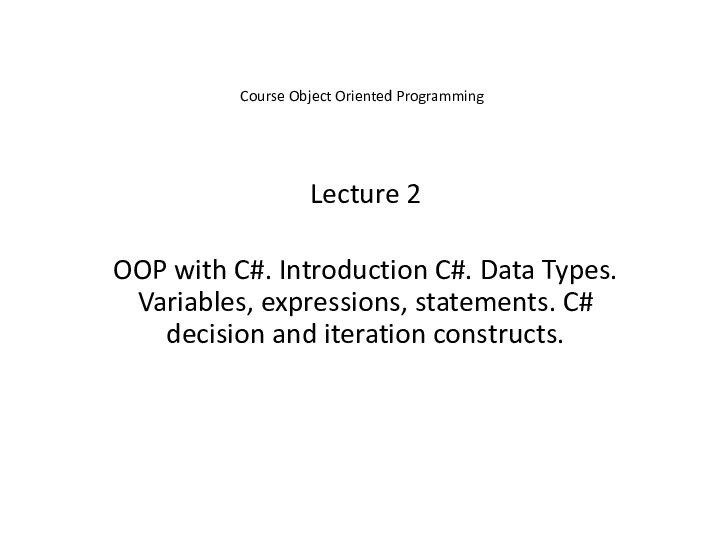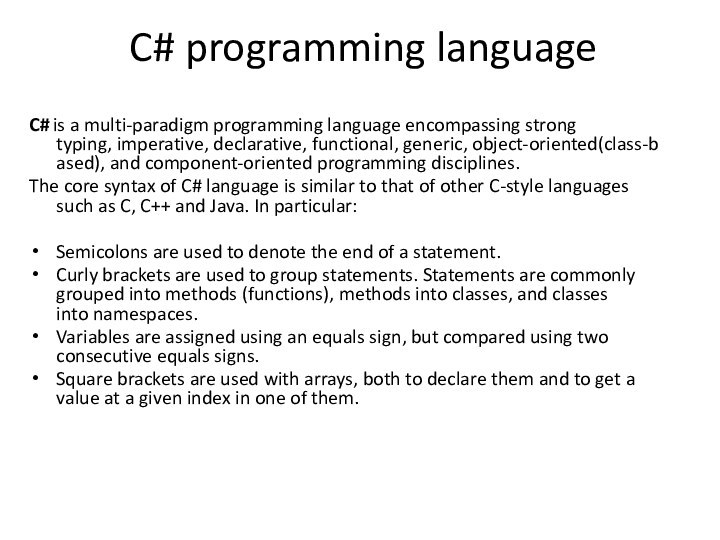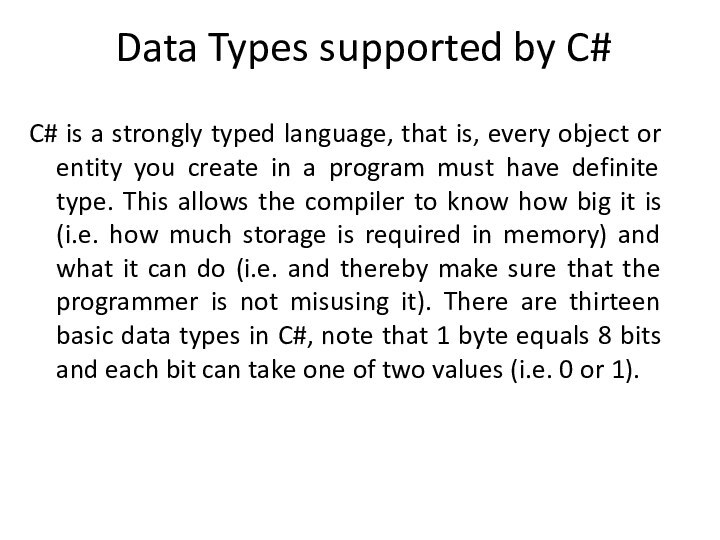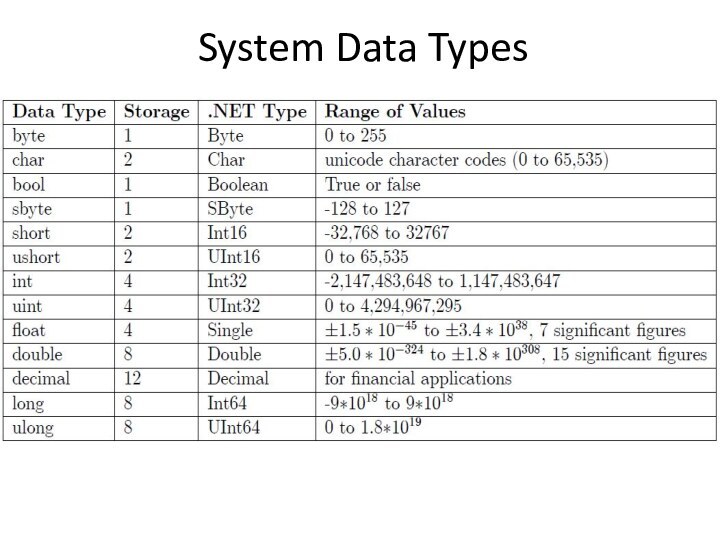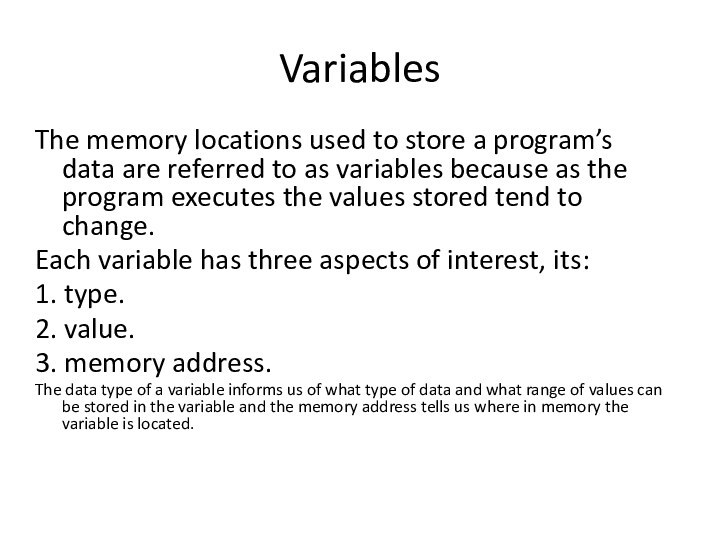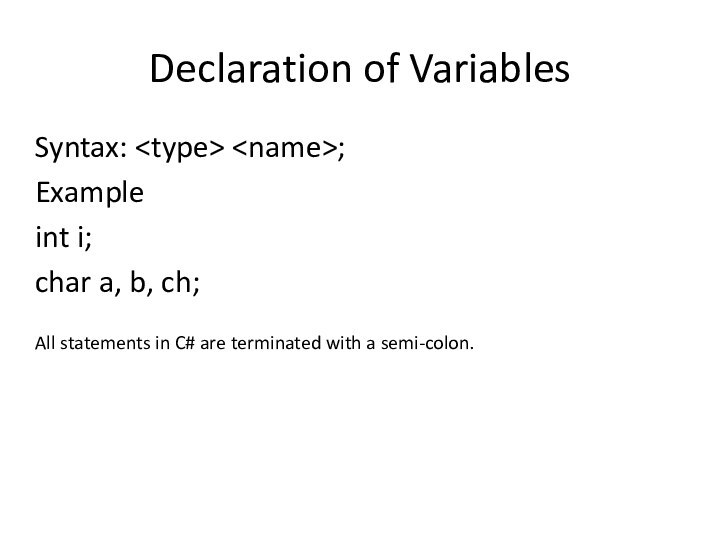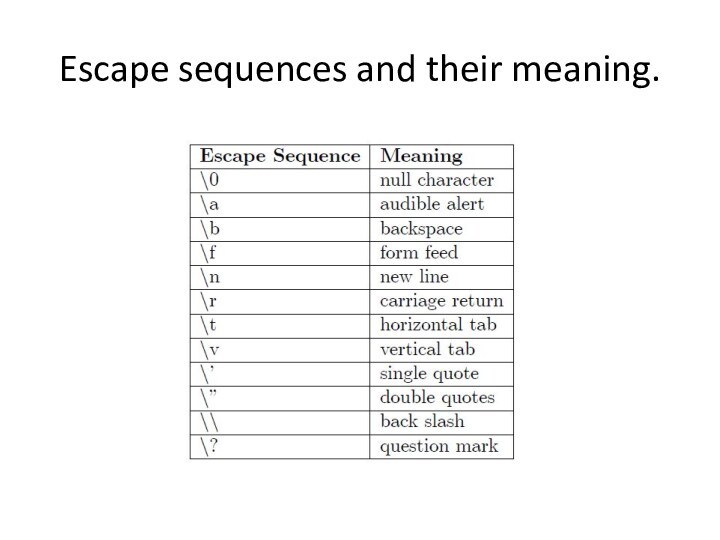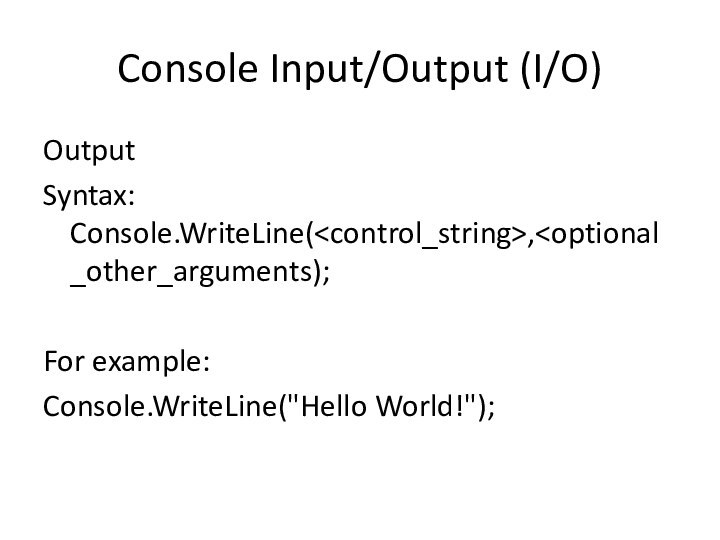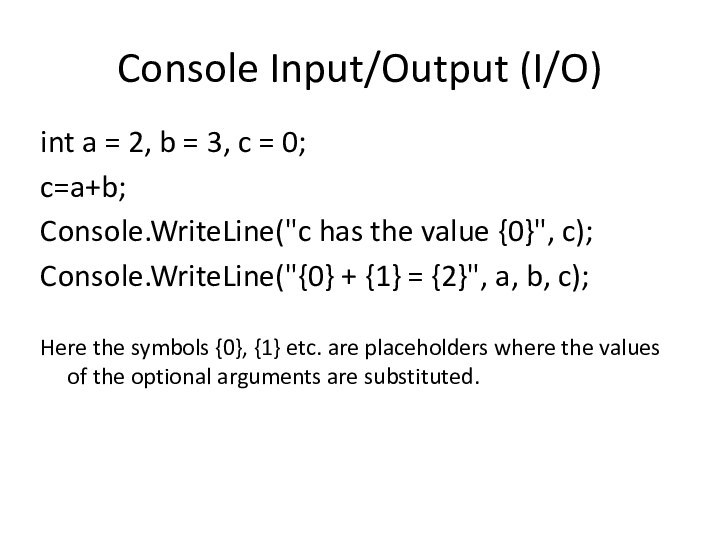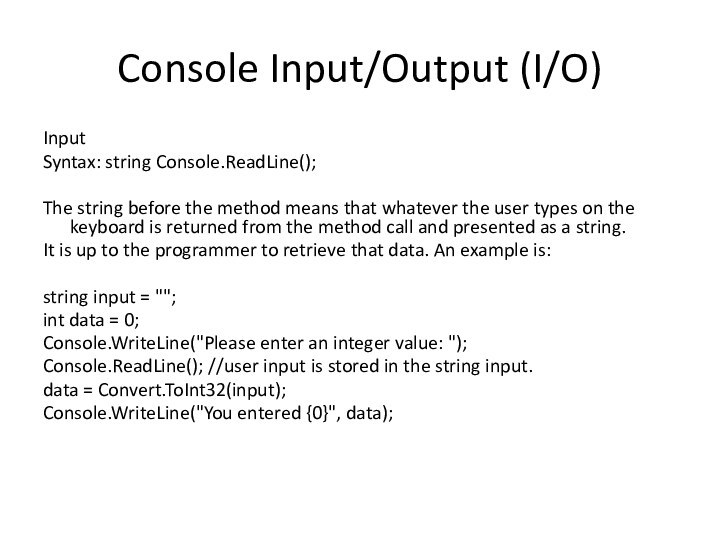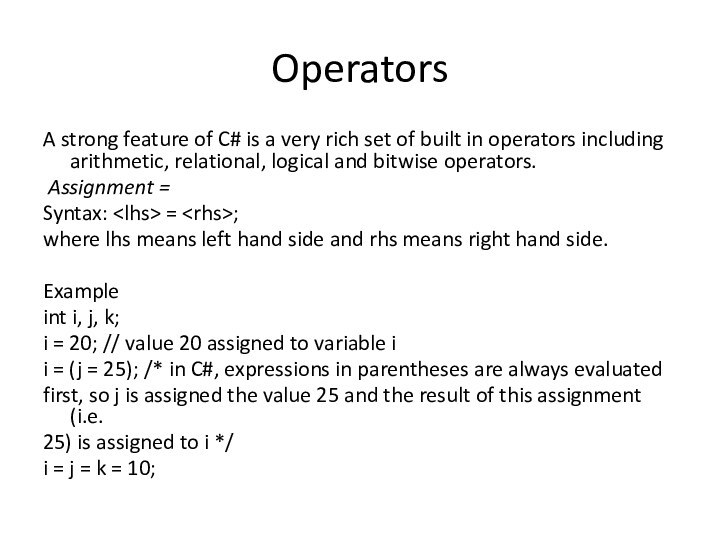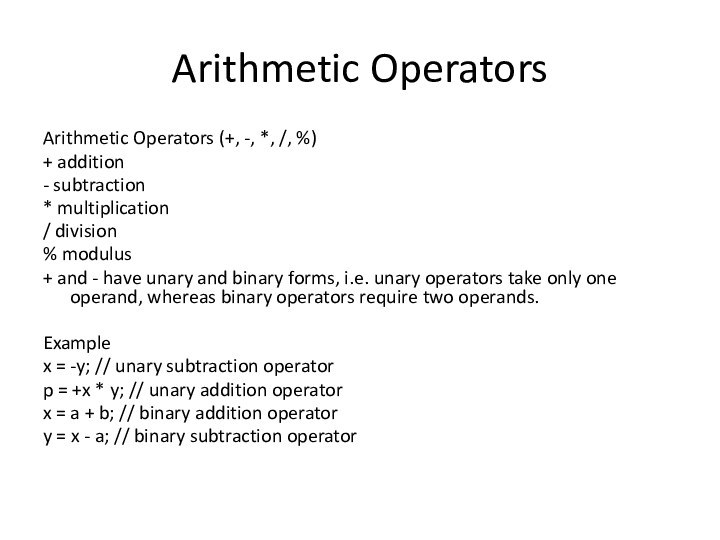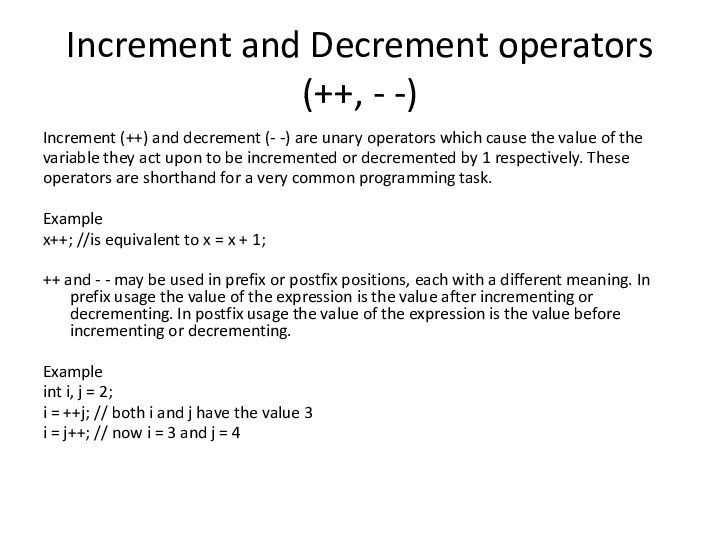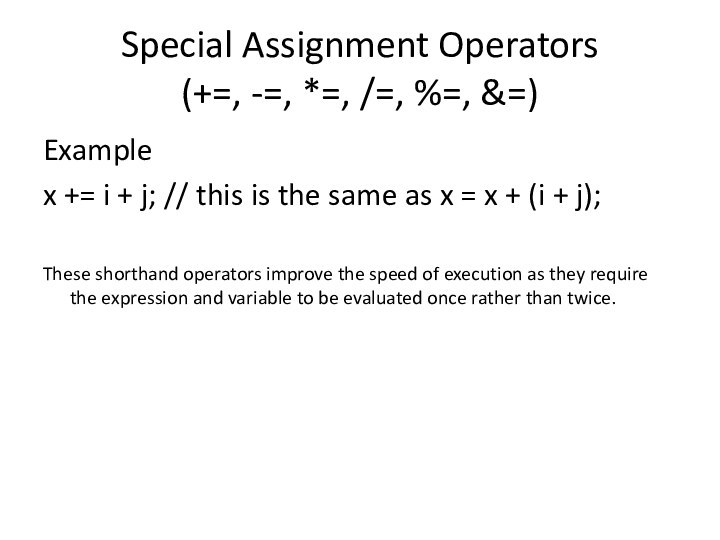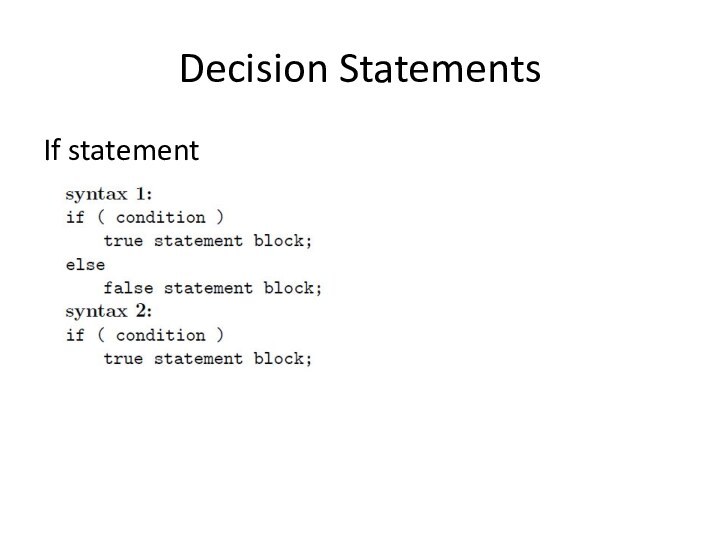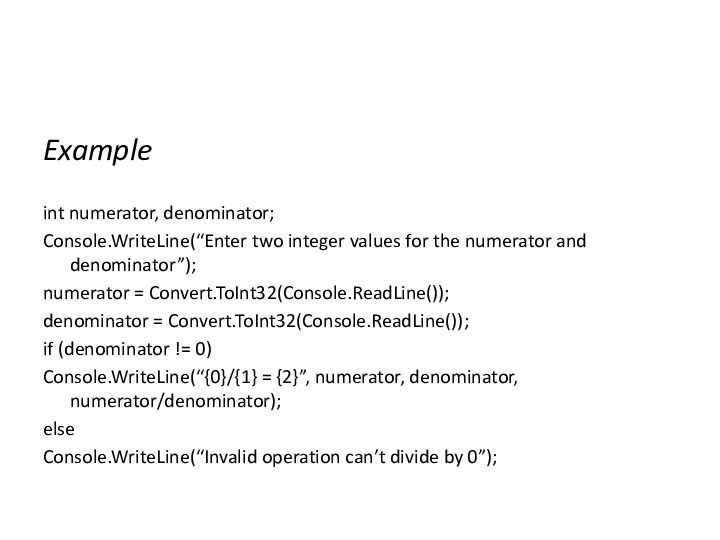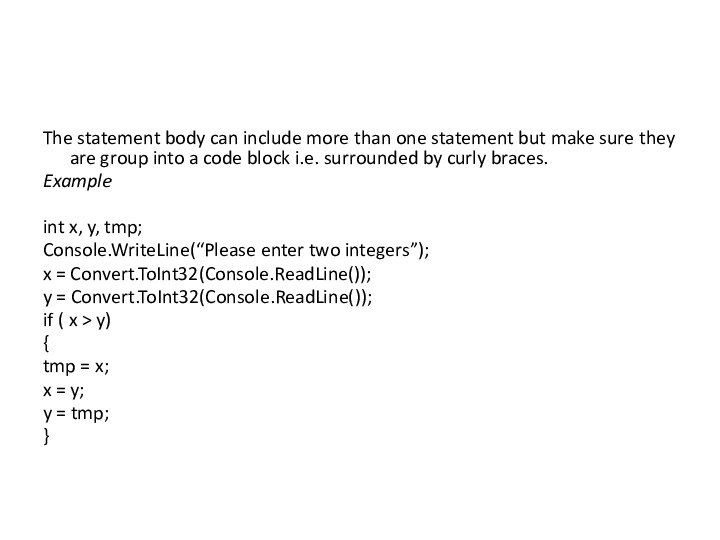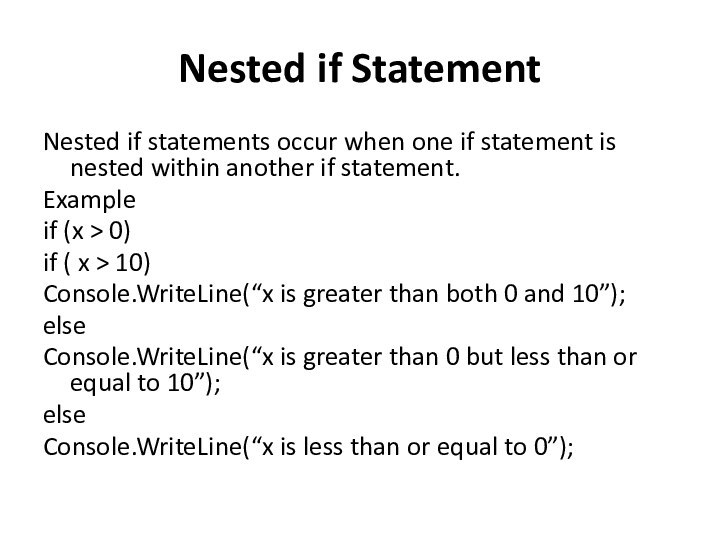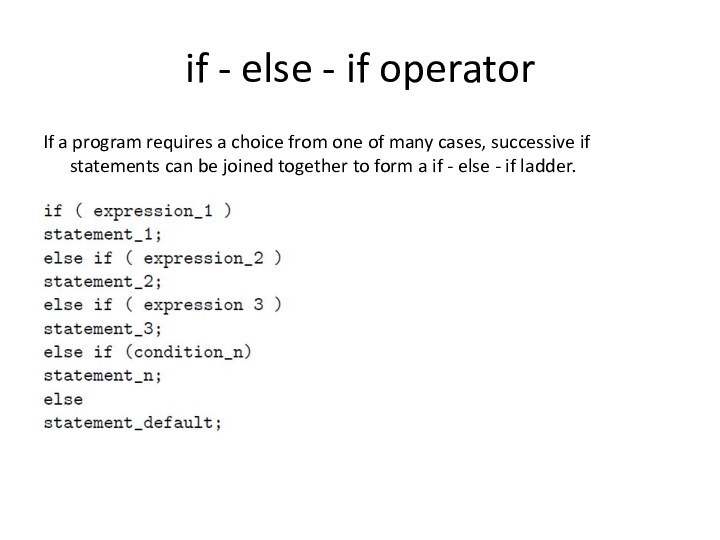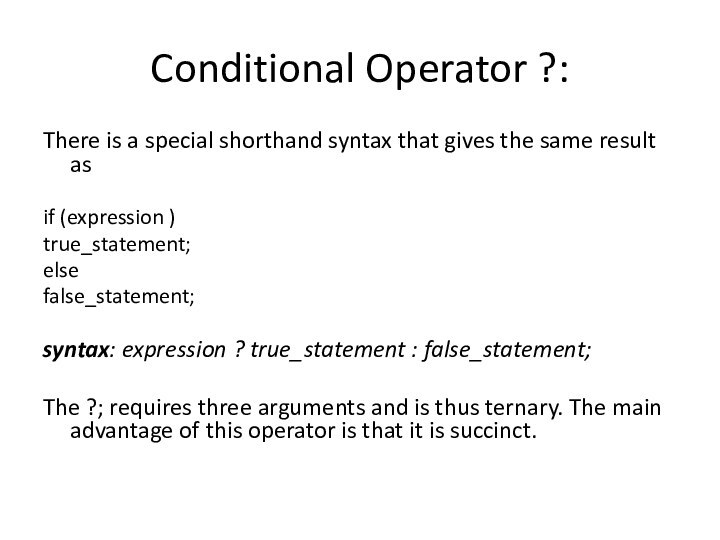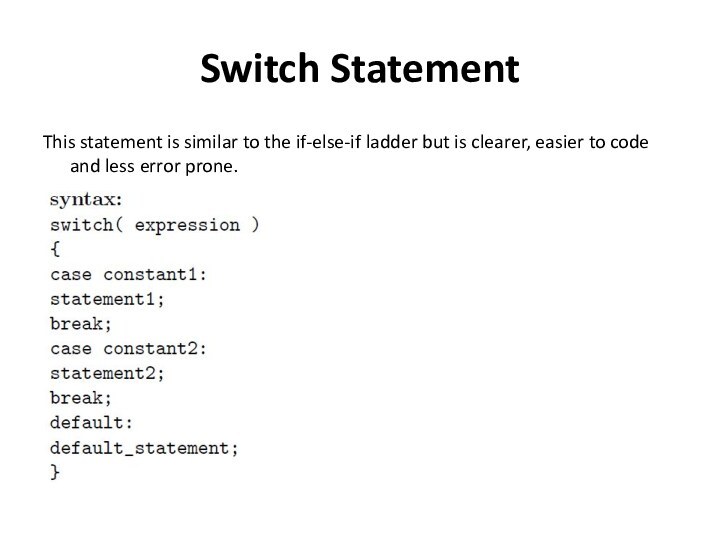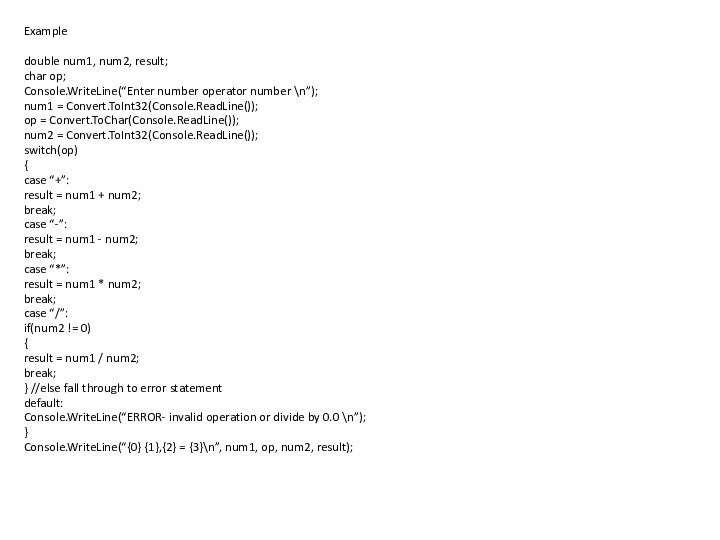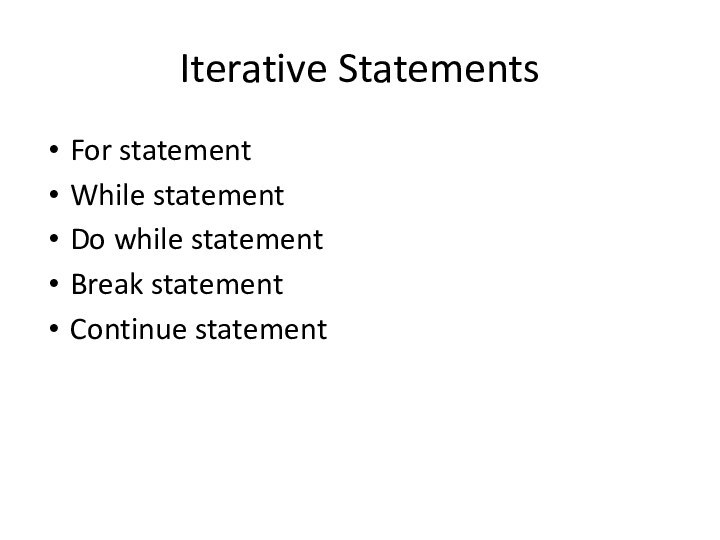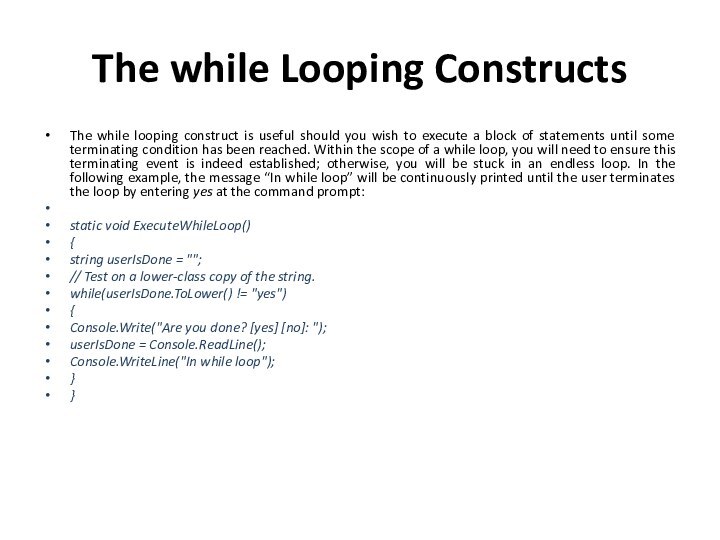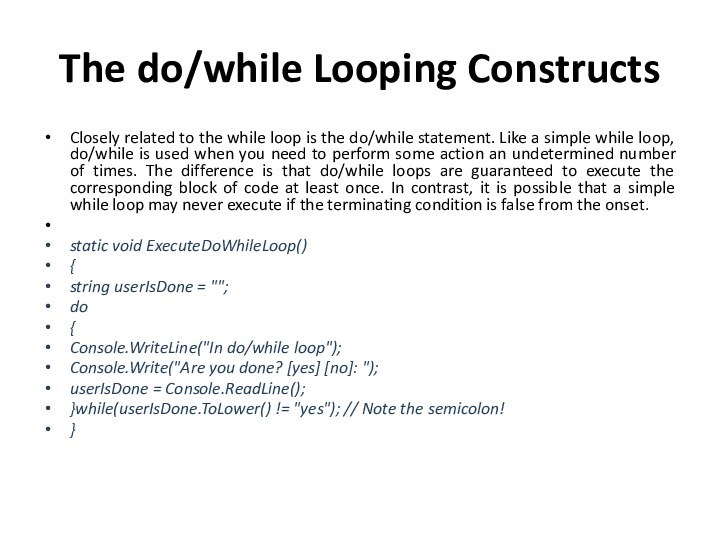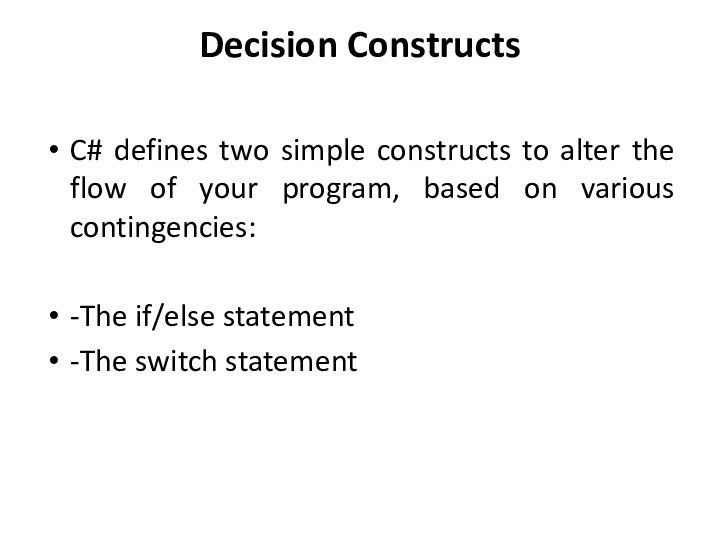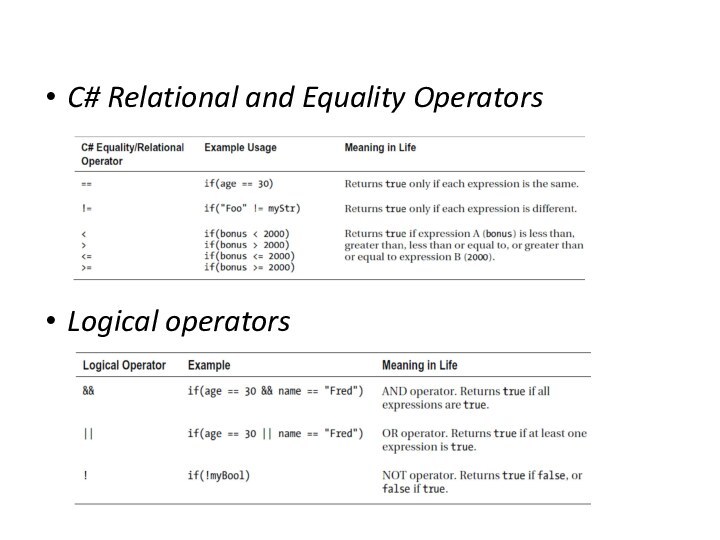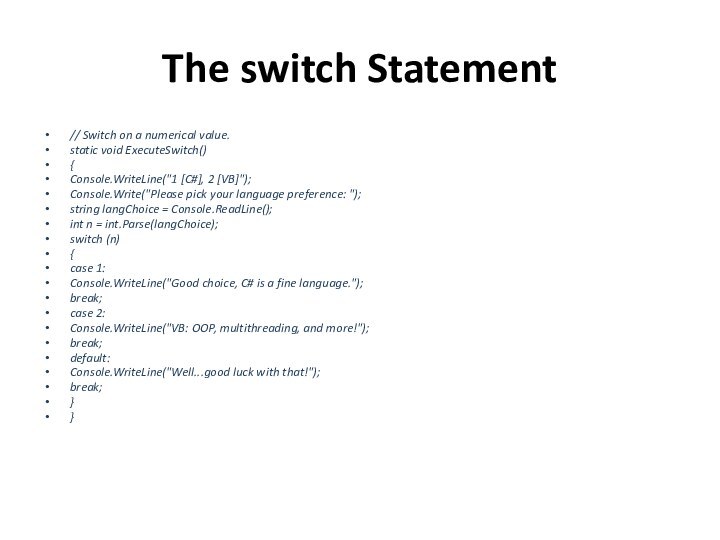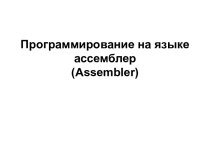Слайд 2
C# programming language
C# is a multi-paradigm programming language encompassing strong typing, imperative, declarative, functional, generic, object-oriented(class-based),
and component-oriented programming disciplines.
The core syntax of C# language is
similar to that of other C-style languages such as C, C++ and Java. In particular:
Semicolons are used to denote the end of a statement.
Curly brackets are used to group statements. Statements are commonly grouped into methods (functions), methods into classes, and classes into namespaces.
Variables are assigned using an equals sign, but compared using two consecutive equals signs.
Square brackets are used with arrays, both to declare them and to get a value at a given index in one of them.
Слайд 3
Data Types
Data is the fundamental currency of the
computer. All computer processing deals with analysis, manipulation and
processing of data. Data is entered, stored and retrieved from computers. It is not surprising then, to learn that data is also fundamental to the C# language.
Слайд 4
Data Types supported by C#
C# is a strongly
typed language, that is, every object or entity you
create in a program must have definite type. This allows the compiler to know how big it is (i.e. how much storage is required in memory) and what it can do (i.e. and thereby make sure that the programmer is not misusing it). There are thirteen basic data types in C#, note that 1 byte equals 8 bits and each bit can take one of two values (i.e. 0 or 1).
Слайд 6
Variables
The memory locations used to store a program’s
data are referred to as variables because as the
program executes the values stored tend to change.
Each variable has three aspects of interest, its:
1. type.
2. value.
3. memory address.
The data type of a variable informs us of what type of data and what range of values can be stored in the variable and the memory address tells us where in memory the variable is located.
Слайд 7
Declaration of Variables
Syntax: ;
Example
int i;
char a, b,
ch;
All statements in C# are terminated with a semi-colon.
Слайд 8
Naming of Variables
The names of variables and functions
in C# are commonly called identifiers. There are a
few rules to keep in mind when naming variables:
1. The first character must be a letter or an underscore.
2. An identifier can consist of letters, numbers and underscores only.
3. Reserved words (int, char, double, …) cannot be used as variable names.
In addition, please note carefully that C# is case sensitive. For example, the identifiers Rate, rate and RATE are all considered to be different by the C# compiler.
Слайд 9
Initialize during variable declaration
Syntax: type var_name = constant;
Example
int
i = 20; //i declared and given the value
20
char ch = ‘a’//ch declared and initialised with value .a.
int i = 2, j = 4, k, l = 5; //i, j and l initialised, k not initialised
Declare first then assign
Example
int i, j, k; //declare
i = 2; //assign
j = 3;
k = 5;
Слайд 10
Escape sequences and their meaning.
Слайд 11
Console Input/Output (I/O)
Output
Syntax: Console.WriteLine(,
Слайд 12
Console Input/Output (I/O)
int a = 2, b =
3, c = 0;
c=a+b;
Console.WriteLine("c has the value {0}", c);
Console.WriteLine("{0}
+ {1} = {2}", a, b, c);
Here the symbols {0}, {1} etc. are placeholders where the values of the optional arguments are substituted.
Слайд 13
Console Input/Output (I/O)
Input
Syntax: string Console.ReadLine();
The string before the
method means that whatever the user types on the
keyboard is returned from the method call and presented as a string.
It is up to the programmer to retrieve that data. An example is:
string input = "";
int data = 0;
Console.WriteLine("Please enter an integer value: ");
Console.ReadLine(); //user input is stored in the string input.
data = Convert.ToInt32(input);
Console.WriteLine("You entered {0}", data);
Слайд 14
Operators
A strong feature of C# is a very
rich set of built in operators including arithmetic, relational,
logical and bitwise operators.
Assignment =
Syntax: = ;
where lhs means left hand side and rhs means right hand side.
Example
int i, j, k;
i = 20; // value 20 assigned to variable i
i = (j = 25); /* in C#, expressions in parentheses are always evaluated
first, so j is assigned the value 25 and the result of this assignment (i.e.
25) is assigned to i */
i = j = k = 10;
Слайд 15
Arithmetic Operators
Arithmetic Operators (+, -, *, /, %)
+
addition
- subtraction
* multiplication
/ division
% modulus
+ and - have unary
and binary forms, i.e. unary operators take only one operand, whereas binary operators require two operands.
Example
x = -y; // unary subtraction operator
p = +x * y; // unary addition operator
x = a + b; // binary addition operator
y = x - a; // binary subtraction operator
Слайд 16
Increment and Decrement operators (++, - -)
Increment (++)
and decrement (- -) are unary operators which cause
the value of the
variable they act upon to be incremented or decremented by 1 respectively. These
operators are shorthand for a very common programming task.
Example
x++; //is equivalent to x = x + 1;
++ and - - may be used in prefix or postfix positions, each with a different meaning. In prefix usage the value of the expression is the value after incrementing or decrementing. In postfix usage the value of the expression is the value before incrementing or decrementing.
Example
int i, j = 2;
i = ++j; // both i and j have the value 3
i = j++; // now i = 3 and j = 4
Слайд 17
Special Assignment Operators
(+=, -=, *=, /=, %=,
&=)
Example
x += i + j; // this is the
same as x = x + (i + j);
These shorthand operators improve the speed of execution as they require the expression and variable to be evaluated once rather than twice.
Слайд 18
Statements
Expression Statements
x = 1;//simple statement
Console.WriteLine(.Hello World!.);//also statement
x =
2 + (3 * 5) – 23;//complex statement
Compound Statements
or Blocks
{
statement
statement
statement
}
Слайд 19
Decision Statements
If statement
Слайд 20
Example
int numerator, denominator;
Console.WriteLine(“Enter two integer values for the
numerator and denominator”);
numerator = Convert.ToInt32(Console.ReadLine());
denominator = Convert.ToInt32(Console.ReadLine());
if (denominator !=
0)
Console.WriteLine(“{0}/{1} = {2}”, numerator, denominator, numerator/denominator);
else
Console.WriteLine(“Invalid operation can’t divide by 0”);
Слайд 21
The statement body can include more than one
statement but make sure they are group into a
code block i.e. surrounded by curly braces.
Example
int x, y, tmp;
Console.WriteLine(“Please enter two integers”);
x = Convert.ToInt32(Console.ReadLine());
y = Convert.ToInt32(Console.ReadLine());
if ( x > y)
{
tmp = x;
x = y;
y = tmp;
}
Слайд 22
Nested if Statement
Nested if statements occur when one
if statement is nested within another if statement.
Example
if (x
> 0)
if ( x > 10)
Console.WriteLine(“x is greater than both 0 and 10”);
else
Console.WriteLine(“x is greater than 0 but less than or equal to 10”);
else
Console.WriteLine(“x is less than or equal to 0”);
Слайд 23
if - else - if operator
If a program
requires a choice from one of many cases, successive
if statements can be joined together to form a if - else - if ladder.
Слайд 25
Conditional Operator ?:
There is a special shorthand syntax
that gives the same result as
if (expression )
true_statement;
else
false_statement;
syntax: expression
? true_statement : false_statement;
The ?; requires three arguments and is thus ternary. The main advantage of this operator is that it is succinct.
Слайд 26
Example
max = x >= y ? x :
y;
which is the equivalent of
if ( x >= y)
max
= x;
else
max = y;
Слайд 27
Switch Statement
This statement is similar to the if-else-if
ladder but is clearer, easier to code and less
error prone.
Слайд 28
Example
double num1, num2, result;
char op;
Console.WriteLine(“Enter number operator number
\n”);
num1 = Convert.ToInt32(Console.ReadLine());
op = Convert.ToChar(Console.ReadLine());
num2 = Convert.ToInt32(Console.ReadLine());
switch(op)
{
case “+”:
result =
num1 + num2;
break;
case “-”:
result = num1 - num2;
break;
case “*”:
result = num1 * num2;
break;
case “/”:
if(num2 != 0)
{
result = num1 / num2;
break;
} //else fall through to error statement
default:
Console.WriteLine(“ERROR- invalid operation or divide by 0.0 \n”);
}
Console.WriteLine(“{0} {1},{2} = {3}\n”, num1, op, num2, result);
Слайд 29
Iterative Statements
For statement
While statement
Do while statement
Break statement
Continue statement
Слайд 30
The while Looping Constructs
The while looping construct is
useful should you wish to execute a block of
statements until some terminating condition has been reached. Within the scope of a while loop, you will need to ensure this terminating event is indeed established; otherwise, you will be stuck in an endless loop. In the following example, the message “In while loop” will be continuously printed until the user terminates the loop by entering yes at the command prompt:
static void ExecuteWhileLoop()
{
string userIsDone = "";
// Test on a lower-class copy of the string.
while(userIsDone.ToLower() != "yes")
{
Console.Write("Are you done? [yes] [no]: ");
userIsDone = Console.ReadLine();
Console.WriteLine("In while loop");
}
}
Слайд 31
The do/while Looping Constructs
Closely related to the while
loop is the do/while statement. Like a simple while
loop, do/while is used when you need to perform some action an undetermined number of times. The difference is that do/while loops are guaranteed to execute the corresponding block of code at least once. In contrast, it is possible that a simple while loop may never execute if the terminating condition is false from the onset.
static void ExecuteDoWhileLoop()
{
string userIsDone = "";
do
{
Console.WriteLine("In do/while loop");
Console.Write("Are you done? [yes] [no]: ");
userIsDone = Console.ReadLine();
}while(userIsDone.ToLower() != "yes"); // Note the semicolon!
}
Слайд 32
Decision Constructs
C# defines two simple constructs to alter
the flow of your program, based on various contingencies:
-The
if/else statement
-The switch statement
Слайд 33
C# Relational and Equality Operators
Logical operators
Слайд 34
The if/else statement
static void IfElseExample()
{
// This is illegal,
given that Length returns an int, not a bool.
string
stringData = "My textual data";
if(stringData.Length)
{
Console.WriteLine("string is greater than 0 characters");
}
}
